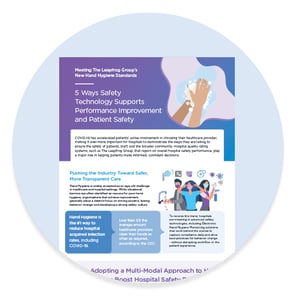Patient Safety Awareness Week is an important annual event organized by the Institute of Healthcare Improvement (IHI), to raise awareness and inspire action to improve the safety of our healthcare system – for patients and the workforce. But if the world has taught us anything in the past few years, patient safety improvement strategies must be prioritized at all times.
Healthcare has been faced with patient safety challenges for over 2 decades, particularly starting when the modern patient safety movement gained its momentum following the Institute of Medicine report, To Err is Human in 1999. When the report was published, it revealed that nearly 98,000 patients died each year in hospitals due to medical errors, bringing to light the magnitude of work to be done to eliminate these avoidable medical events.
Just as industry leaders began commemorating and reflecting on this 20 year milestone – including the incredible progress that has been made toward better outcomes, while also setting important goals for forward-thinking quality improvement, The World Health Organization declared COVID-19 a global pandemic. From that point on, the conversation immediately shifted from proactively advancing patient safety, to reactionary crisis response efforts.
Top Three Considerations for Hospitals Around Building the Future of Patient Safety
While safety is always top of mind in healthcare, several barriers, including COVID-19, can impact an organization’s ability to maintain best practices for safe care. As hospitals consider where their strategies might fall short as they plan for the next year, now is an opportune time to address these barriers and the necessary investments to safeguard the future of patient safety.
1. What impact has COVID-19 had on hospital-acquired infections (HAIs) rates and patient safety?
When patients come to a hospital, they trust that they won’t leave sicker than when they arrived. However, even before COVID-19, hospitals and healthcare organizations have long tackled the challenge of HAIs, which have historically posed serious risks to patient safety and costly consequences for hospitals. Despite significant progress over the past decade to eliminate HAIs, each day, approximately one in 31 U.S. patients have at least one infection in association with their hospital care, underscoring the need for improvements. Furthermore, the pandemic has caused setbacks in these efforts.
Recovery planning presents a silver-lined opportunity for hospitals, and our health system as a whole, to get back on track towards safer care. The future of hospital safety requires innovative solutions that not only reduce the current risks of COVID-19, but also improve on fundamental changes to reducing HAIs in order to:
- Restore patient confidence in seeking care: Since the start of COVID-19, more than 40% of adults have delayed essential and preventative care in fear of contracting harm within the four walls of a healthcare facility; and this risk-averse mindset is expected to continue.
- Improve patient experience and health outcomes: Beyond the health impacts and mortality risks of an HAI, the average patient who contracts an HAI stays in the hospital an extra 10 days, causing a significant impact on quality of life.
- Confidently ensure safety preparedness: Infection prevention teams have had to divert all of their resources to managing the spread of COVID-19, forcing their focus away from HAI prevention and surveillance. According to the American Journal of Infection Control, case rates for common HAIs, most notably CLABSI and CAUTI have risen significantly and experts predict that this trend could continue.
At the most fundamental level, hand hygiene is the number one way for hospitals to reduce the spread of HAIs. In fact, studies point to 80% hand hygiene compliance as being a critical threshold for reducing infections. Access our Hand Hygiene Guide to discover the ways electronic hand hygiene monitoring technology can help boost compliance improvement and drive positive, lasting behavior change.
2. Do our healthcare workers and hospital staff feel safe and supported?
In order for patients to feel safe, the healthcare workers treating them must also feel safe. According to a Gallup Workplace Survey, at the pandemic’s peak last year, only 36% of full-time healthcare workers in the U.S. strongly agreed that they felt confident in their organization’s health policies to protect them against COVID-19. Despite this uncertainty, healthcare workers demonstrated a tireless dedication to saving lives on the front lines.
In the event of an infectious disease outbreak, hospitals must act fast to manage and prevent further exposure. Traditionally, hospitals have relied on laborious, manual methods to measure risk. These methods can take up to two weeks or longer to determine exposure, often rely on staff recall, and are ultimately deemed unreliable in protecting staff and patients.
With the rapid spread of COVID-19, these manual processes are proved to be untenable, resulting in healthcare workers being sent home unnecessarily at a time when critical care experts were needed.
Catalyzed by the increasing demands of maintaining patient safety, numerous hospitals across the country are turning to transformative safety technologies to ensure preparedness inside their facilities. Leveraging real-time, employee-level data, Automated Contact Tracing captures all employee-to-patient, and employee-to-employee contacts. This enables infection control and occupational health staff to generate an initial list of at-risk staff and patients within a few minutes. “From an enterprise viewpoint, we implemented contact tracing because we needed the ability to assure the community, our staff, and our patients and their families that it was safe to come to the hospital and that you weren’t going to leave here sicker than when you got here,” said Cliff Daniels, Chief Strategy Officer at Methodist Hospital of Southern California. “Contact Tracing has enabled us the ability to track, contain and mitigate the spread of coronavirus in the hospital.”
Working in the background alongside traditional infection prevention protocols, including PPE, adequate cleaning, hand hygiene, and other safety practices, badge-based technology solutions, like SwipeSense are prompting patients and staff to confidently resume regular care.
3. Is my hospital prepared to meet evolving safety standards?
COVID-19 has further accelerated patients’ active involvement in choosing their healthcare providers. Several organizations, such as The Leapfrog Group, are dedicated to reporting on overall safety performance metrics to help patients make informed, confident decisions about their healthcare.
As patient expectations evolve and innovative safety solutions increasingly prove effective in meeting their needs, these organizations also play a critical role in defining new industry standards for the future of safety. At the same time, the link between COVID-19 and an increased risk for HAIs, emphasizes the importance of improving hand hygiene behavior in healthcare settings. While hand hygiene is widely accepted as the most effective way to reduce the spread of HAIs, healthcare workers wash their hands less than half of the time required, according to the CDC.
In a continuous, steadfast effort to improve hand hygiene compliance in hospital and ambulatory surgery center (ASC) facilities, The Leapfrog Group has added new standards for hand hygiene best practices as part of The 2021 Hospital Survey. These new standards encourage a multi-modal approach to hand hygiene and emphasize the impact of adopting electronic monitoring tools to effectively measure and improve hand hygiene compliance.
Download our Hand Hygiene Guide to learn how electronic hand hygiene monitoring plays a critical role in meeting The Leapfrog Group’s updated standards for hand hygiene, including: 
- Monitoring
- Feedback
- Culture
- Training & Education
- Infrastructure
Let’s continue the conversation. Our team is passionate about patient safety and the ways our safety platform can further support modern patient safety infrastructure.
